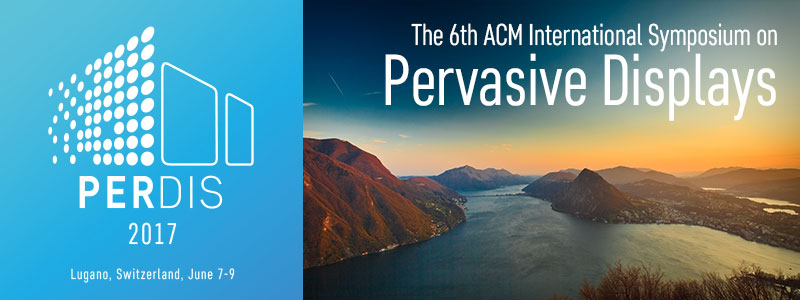

|
9:00 |
Registration opens |
|
Tutorials |
|
|
9:30-11:00 |
Public Display Analytics (Part 1) Understanding Digital Signage Analytics Tutorial 1 |
|
11:00-11:30 |
Coffee Break |
|
11:30-13:00 |
Public Display Analytics (Part 2) Hands-on Lab: Analysing Video Usage Logs using Jupyter Tutorial 1 |
|
13:00-14:30 |
Lunch Break |
|
14:30-16:00 |
Urban Information Visualization (Part 1) An Introduction to Information Visualisation Tutorial 2 |
|
16:00-16:30 |
Coffee Break |
|
16:30-18:00 |
Urban Information Visualization (Part 2) Visualizing and Interacting Data in Urban Spaces Tutorial 2 |
|
19:00 – |
Drinks at the Lake - El Mojito Tropical Lounge |
|
8:30 |
Registration opens |
|
9:15-9:30 |
Welcome |
|
9:30-10:30 |
Opening Keynote: Start Thinking in 3D |
|
10:30-11:00 |
Coffee Break |
|
11:00-12:50 |
Session 1: Applications – Chair: Florian Alt Framing fraught topics through tangible multi-display engagement with live news – Paper StickySchedule: An Interactive Multi-user Application for Conference Scheduling on Large-scale Shared Displays – Paper Orchestrating Multi-Device Presentations with OmniPresent – Paper Ghost-Hack AR: Human Augmentation Using Multiple Telepresence Systems for Network Communication – Paper Exploring the Design of Stereoscopic 3D for Multilevel Maps – Paper |
|
13:00-14:10 |
Lunch Break |
|
14:10-15:45 |
Session 2: Interaction Modalities – Chair: Ivan Elhart Exploring Spatial Meaning with a Tangible Map – Paper Avoid the Use of Audio? Evaluating the Influence of Sound in a Large Display Multi-User Scenario – Paper GTmoPass: Two-factor Authentication on Public Displays Using Gaze-Touch passwords and Personal Mobile Devices – Paper The Concurrent Use of Touch and Mid-Air Gestures or Floor Mat Interaction on a Public Display A multimodal interaction system for big displays – Video |
|
15:45-16:50 |
Coffee and Poster/Demo Session |
|
16:50-18:05 |
Session 3: Audience and Performance – Chair: Matthias Baldauf Design Considerations for Multi-Stakeholder Display Analytics – Paper They are looking at me! Understanding how Audience Presence Impacts on Public Display Users – Paper Sunken Ripples: Exploring the Design Space of Performative Interfaces with Non-Planar Displays – Paper The Lone Star Digital Memorial: A Case Study in Pervasive Displays – Video Emojis on the Facade: Exploring Social Media Graphics to Transmit Urban Issues on Media Facades – Video |
|
19:00 – |
Drinks & Dinner at the Lake - Lanchetta Lounge |
|
8:30 |
Registration opens |
|
9:00-10:10 |
Session 4: Platforms and Frameworks – Chair: Rui Jose ScreenPress: A Powerful and Flexible Platform for Networked Pervasive Display Systems – Paper Code the Globe: Interactive Content for Spherical Displays with simple Webpages – Paper P+: A Test Fit Platform for Generative Design of 3D Media Architecture – Paper P+: A Test Fit Platform for Generative Design of 3D Media Architecture – Video |
|
10:10-10:30 |
Coffee Break |
|
10:30-11:35 |
Session 5: Informing Research – Chair: Nigel Davies Multi-purpose place-based display systems: implications from current practices with non-digital displays – Paper Public displays for public participation in urban settings: a survey – Paper Audience Monitor – an Open Source Tool for Tracking Audience Mobility in front of Pervasive Displays – Paper |
|
11:35-11:50 |
Coffee Break |
|
11:50-13:00 |
Session 6: Users: Engagement and Cognition – Chair: Julie Williamson Better Off: When Should Pervasive Displays be Powered Down? – Paper Fostering Large Display Engagement Through Playful Interactions – Paper Investigating how User Avatar in Touchless Interfaces Affects Perceived Cognitive Load and Two-Handed Interactions – Paper |
|
13:00-14:10 |
Lunch Break |
|
14:10-15:15 |
Townhall |
|
15:15-16:00 |
Farewell Coffee |
As it has become customary for PerDis, we will again offer a two in-depth tutorials on the first day of the symposium. The tutorials will take place on June 7. Attendace is included in your registration fee.
Public Display Analytics
Dr. Julie R. Williamson (Glasgow University, UK), Mateusz Mikusz (Lancaster University, UK), and Ivan Elhart (USI Lugano, CH)
This tutorial will introduce students to the general field of digital signage analytics and explore ways to collect, process, and understand usage data of public display installations. It will cover data collected both via usage logs and cameras (visual analytics). It features both a theoretical, lecture-style part (Part 1), as well as a hands-on lab (Part 2) where students will experience practical ways to analyse public display usage data (using Jupyter). Students should bring their own laptops, though we can also provide laptops if needed (please contact ivan.elhart@usi.ch at least one week in advance).
Julie Williamson is a lecturer in HCI at the University of Glasgow. Julie is part of the Glasgow Interactive Systems Group (GIST), leading the Public and Performative Interaction theme within GIST. Her research focuses on how people use technology in public spaces and how interactive technologies can be designed given the "performative" aspects of using technology in public. Her current research looks at playful interfaces for public spaces the use embedded interaction, large format displays, and whole body input.
Mateusz Mikusz is a third-year PhD student in Computer Science and Research Associate at Lancaster University. His research focuses on pervasive analytics, mainly in the context of digital signage and pervasive display networks. Prior to his PhD studies, Mateusz graduated from the University of Stuttgart. Throughout his studies, he has been involved in a number of projects including PD-NET and RECALL, and is now working on PETRAS.
Ivan Elhart is a Postdoctoral Researcher at the Faculty of Informatics at the University of Lugano (USI), Switzerland. Ivan received a master degree (Diploma) in Electrical and Computer Engineering from the University of Novi Sad, Serbia, in 2006, a master degree in Electrical and Computer Engineering from the University of New Hampshire, USA, in 2009, and his PhD (Dr. sc.) from the University of Lugano (USI), in 2015. His research interests are in the area of pervasive public display systems, in particular opportunities for distributed application and content scheduling.
Urban Information Visualization
Prof. Florian Alt (LMU, Germany) and Jorgos Coenen (KU Leuven, BE)
Smart cities start with smart citizens. Increasingly, efforts are made to open up urban data and disclose it to the general public. However, open data is only a first step. This tutorial focusses on encountering, interpreting, and discussing this information in the city. The tutorial will start with a general introduction to information visualization (Part 1 by Prof. Florian Alt) and continue with a deeper dive into visualizing and interacting with data in public and urban spaces (Part 2 by Jorgos Coenen). The second session will include a brief theoretical part and a hands-on part where participants will brainstorm in groups about bringing specific data sets to urban contexts.

Florian Alt holds a full-time appointment as an assistant professor in the group for media informatics (Medieninformatik) at LMU in Munich, Germany. Florian is doing research at the crossroads of ubiquitous computing and HCI. His particular research interests are on open pervasive displays, cognitive effects of interaction, 3D displays, and usable security.
Jorgos Coenen is a PhD student in the Research[x]Design group at the Department of Architecture of KU Leuven, working with Prof. Andrew Vande Moere. Jorgos has a background in Communication and Media Design, with a focus on interaction design. His research interests include interaction in public space and information visualization, aiming to bring data regarding physical activity to public space in engaging, interactive and motivating ways.

Prof. Michael Bronstein
USI Lugano, CH, and Tel Aviv University, IL
Michael Bronstein is an associate professor of Informatics at USI Lugano in Switzerland, associate professor of Applied Mathematics at Tel Aviv University in Israel, and a Principal Engineer at the Intel Perceptual Computing group. Michael got his Ph.D. with distinction in Computer Science from the Technion in 2007. He has previously held visiting appointments at Politecnico di Milano, Stanford, INRIA, Technion, and University of Verona. He is a Senior Member of the IEEE, alumnus of the Technion Excellence Program and the Academy of Achievement, ACM Distinguished Speaker, and a member of the Young Academy of Europe. His research appeared in the international media such as CNN and was recognized by numerous prestigious awards, including several best paper awards, the Hershel Rich Innovation Award (2003), three ERC grants (Starting Grant 2012, Proof of Concept Grant 2016, and Consolidator Grant 2016), Google Faculty Research Award (2016), Radcliffe Fellowship from the Institute for Advanced Study at Harvard University (2017), and Rudolf Diesel Industrial Fellowship from TU Munich (2017). In 2014, he was selected as a Young Scientist by the World Economic Forum, an honor bestowed on forty world's leading scientists under the age of forty. He was a guest speaker at the World Economic Forum meeting in Dalian, China in 2015. Michael is the author of the first book on deformable 3D shape analysis, editor of four books, over 100 papers in top scientific journals and conferences, and inventor of over 20 granted patents. He has chaired over a dozen of conferences and workshops in his field, and has served as area chair at ECCV 2016 and ICCV 2017 and as associate editor of the Computer Vision and Image Understanding journal. He has given over 70 invited and keynote talks during his career. Besides academic work, Michael is actively involved in the industry. He has co-founded and served in leading technical and management positions at several startup companies, including Invision, an Israeli startup developing 3D sensing technology acquired by Intel in 2012. This technology can now be found in new generation of computers from all the major brands.
Orchestrating Multi-Device Presentations with OmniPresent
Maria Husmann, Daniel Huguenin, Matthias Geel and Moira Norrie
ScreenPress: A Powerful and Flexible Platform for Networked Pervasive Display Systems
Amir Esmaeil Sarabadani Tafreshi and Moira Norrie
Avoid the Use of Audio? Evaluating the Influence of Sound in a Large Display Multi-User Scenario
Andrea Nutsi and Michael Koch
GTmoPass: Two-factor Authentication on Public Displays Using Gaze-Touch passwords and Personal Mobile Devices
Mohamed Khamis, Regina Hasholzner, Andreas Bulling and Florian Alt
P+: A Test Fit Platform for Generative Design of 3D Media Architecture
Marius Hoggenmueller and Luke Hespanhol
StickySchedule: An Interactive Multi-user Application for Conference Scheduling on Large-scale Shared Displays
Vishal Doshi, Sneha Tuteja, Krishna Bharadwaj, Davide Tantillo, James Patton, Thomas Marrinan and G. Elisabeta Marai
Fostering Large Display Engagement Through Playful Interactions
Jane Henderson, Shaishav Siddhpuria, Keiko Katsuragawa and Edward Lank
The Concurrent Use of Touch and Mid-Air Gestures or Floor Mat Interaction on a Public Display - ![]() Best Paper Award
Best Paper Award
Jorgos Coenen, Sandy Claes and Andrew Vande Moere
Multi-purpose place-based display systems: implications from current practices with non-digital displays
Pedro Coutinho and Rui José
Better Off: When Should Pervasive Displays be Powered Down?
Nigel Davies, Sarah Clinch, Mateusz Mikusz, Oliver Bates, Helen Turner and Adrian Friday
They are looking at me! Understanding how Audience Presence Impacts on Public Display Users
Vito Gentile, Mohamed Khamis, Salvatore Sorce and Florian Alt
Audience Monitor – an Open Source Tool for Tracking Audience Mobility in front of Pervasive Displays
Ivan Elhart, Mateusz Mikusz, Cristian Gomez Mora, Marc Langheinrich and Nigel Davies
Sunken Ripples: Exploring the Design Space of Performative Interfaces with Non-Planar Displays
Julie Williamson, John Williamson and Daniel Sunden
Public displays for public participation in urban settings: a survey
Guiying Du, Auriol Degbelo and Christian Kray
Exploring Spatial Meaning with a Tangible Map
Will Walker, Hyungie Sung, Chris Kevin Ong and Federico Casalegno
Ghost-Hack AR: Human Augmentation Using Multiple Telepresence Systems for Network Communication
Hiroaki Tobita
Code the Globe: Interactive Content for Spherical Displays with simple Webpages
Thomas Crespel, Brett Ridel, Clara Rigaud, Anke M. Brock and Patrick Reuter
Exploring the Design of Stereoscopic 3D for Multilevel Maps
Juho Rantakari, Jani Väyrynen, Ashley Colley and Jonna Hakkila
Design Considerations for Multi-Stakeholder Display Analytics
Mateusz Mikusz, Sarah Clinch and Nigel Davies
Investigating how User Avatar in Touchless Interfaces Affects Perceived Cognitive Load and Two-Handed Interactions
Vito Gentile, Salvatore Sorce, Alessio Malizia, Fabrizio Milazzo and Antonio Gentile
Framing fraught topics through tangible multi-display engagement with live news
Brygg Ullmer, Blake Tregre and Malcolm McClay
StickySchedule: An Interactive Multi-user Application for Conference Scheduling on Large-scale Shared Displays
Vishal Doshi, Sneha Tuteja, Krishna Bharadwaj, Davide Tantillo, James Patton, Thomas Marrinan and G. Elisabeta Marai
Better Off: When Should Pervasive Displays be Powered Down?
Mateusz Mikusz, Nigel Davies, Ivan Elhart, Marc Langheinrich
Levitate: Interaction with Floating Particle Displays
Julie Williamson, Euan Freeman and Stephen Brewster
Wearable Augmented Reality Display for Wellness
Jonna Häkkilä, Ashley Colley, Paula Roinesalo, Tuomas Lappalainen, Inka Rantala and Jani Väyrynen
Multimodal Head-Mounted Display for Multimodal Alarms in Intensive Care Units
Vanessa Cobus, Wilko Heuten and Susanne Boll
Exploiting Social Comparison using Pervasive Displays and Mobile Notifications for Reducing Energy Consumption
Vito Gentile and Vasiliki Mylonopoulou
ProductFinder: A Location Aware Product Information Display For Retail Environments
Marco Speicher, Rudolf Siegel and Antonio Krueger
The Lone Star Digital Memorial: A Case Study in Pervasive Displays
David Wilson
A multimodal interaction system for big displays
Ana M. Bernardos, Ana Muñoz, Luca Bergesio, Juan Alberto Besada and José Ramón Casar
P+: A Test Fit Platform for Generative Design of 3D Media Architecture
Marius Hoggenmueller and Luke Hespanhol
Emojis on the Facade: Exploring Social Media Graphics to Transmit Urban Issues on Media Facades
Andre Afonso, Luiza Braganca, Alisson Couto, Sandro Miccoli, Marcelo Padovani and Ava Fatah Schieck